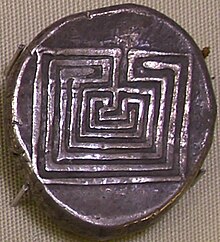
| Part of a series on |
| Greek mythology |
|---|
 |
| Deities |
| Heroes and heroism |
| Related |
|
|
In Greek mythology, the Labyrinth (Ancient Greek: λαβύρινθος, romanized: Labúrinthos)[a] is an elaborate, confusing structure designed and built by the legendary artificer Daedalus for King Minos of Crete at Knossos. Its function was to hold the Minotaur, the monster eventually killed by the hero Theseus. Daedalus had so cunningly made the Labyrinth that he could barely escape it after he built it.[1]
Although early Cretan coins occasionally exhibit branching (multicursal) patterns,[2] the single-path (unicursal) seven-course "Classical" design without branching or dead ends became associated with the Labyrinth on coins as early as 430 BC,[3] and similar non-branching patterns became widely used as visual representations of the Labyrinth – even though both logic and literary descriptions make it clear that the Minotaur was trapped in a complex branching maze.[4] Even as the designs became more elaborate, visual depictions of the mythological Labyrinth from the Roman era until the Renaissance are almost invariably unicursal. Branching mazes were reintroduced only when hedge mazes became popular during the Renaissance.[5]
In English, the term labyrinth is generally synonymous with maze. As a result of the long history of unicursal representation of the mythological Labyrinth, however, many contemporary scholars and enthusiasts observe a distinction between the two. In this specialized usage, maze refers to a complex branching multicursal puzzle with choices of path and direction, while a unicursal labyrinth has only a single path to the center. A labyrinth in this sense has an unambiguous route to the center and back and presents no navigational challenge.[6][7][8][9]
Unicursal labyrinths appeared as designs on pottery or basketry, as body art, and in etchings on walls of caves or churches. The Romans created many primarily decorative unicursal designs on walls and floors in tile or mosaic. Many labyrinths set in floors or on the ground are large enough that the path can be walked. Unicursal patterns have been used historically both in group ritual and for private meditation, and are increasingly found for therapeutic use in hospitals and hospices.[10]
Cite error: There are <ref group=lower-alpha> tags or {{efn}} templates on this page, but the references will not show without a {{reflist|group=lower-alpha}} template or {{notelist}} template (see the help page).
- ^ Doob 1992, p. 36
- ^ Kern, Through the Labyrinth, 2000, item 43, p. 53.
- ^ Kern, Through the Labyrinth, 2000, item 50, p. 54.
- ^ Penelope Reed Doob, The Idea of the Labyrinth, pp. 40–41.
- ^ McCullough, David (2004). The Unending Mystery. New York: Pantheon. pp. 113–124. ISBN 0375423060.
- ^ Kern, Through the Labyrinth, p. 23.
- ^ The usage restricting maze to patterns that involve choices of path is mentioned by Matthews (p. 2–3) as early as 1922, though he does not find the distinction useful and does not follow it himself.
- ^ Jeff Saward. "Mazes or Labyrinths?" (PDF). Labyrinthos. Retrieved 28 December 2017.
- ^ "About Labyrinths". The Labyrinth Society. Retrieved 18 September 2015.
- ^ McCullough, David (2004). The Unending Mystery. New York: Pantheon. pp. 184–187. ISBN 0375423060.